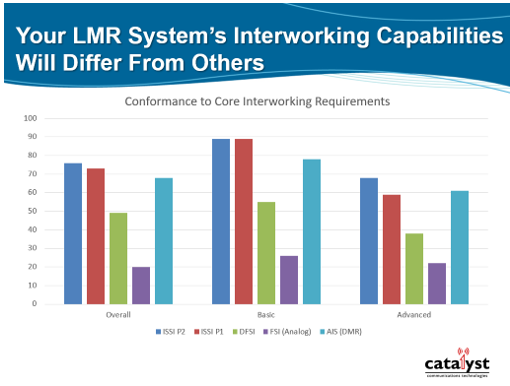Conclusions from DHS S&T Funded research highlight new First Responder technology at IWCE 2019
IWCE 2019, Las Vegas NV – March 5, 2019
- Interworking between LMR and LTE (including FirstNet™) is feasible
- Most radio systems can be Interworked; P25 ISSI is not required
- Interworking features vary with each radio system
These are some of the conclusions reported by Catalyst Communications Technologies after a year long study of LMR – LTE Interworking requirements and existing standards.
Catalyst Communications Technologies, Inc., a leading developer of Radio Control over IP Dispatch, Interoperability and Incident Command solutions for the mission critical / first responder community, has completed the research study they began in early 2018 to analyze how a standards based Interworking Solution could enable mission critical communications between users of Land Mobile Radio systems and users on mobile / cell phones with push to talk applications. The research was the result of an Award by the Department of Homeland Security’s Science and Technology Initiative in support of a solicitation won by Catalyst in competition with other US businesses.
The need for an Interworking solution between LMR and LTE radio systems is substantial. As users discover applications where push to talk on a mobile phone will support essential new capabilities and be less expensive than LMR subscriber radios, this migration will need interoperability and dispatch systems that can ensure communications among First Responders and others that are using these different systems.
The Research was undertaken to determine the feasibility and the architecture of a reliable, secure and standards-based LMR/P25 – LTE Mission Critical Network (e.g. MCPTT) interface service for both:
1) The different LMR systems in use today
2) The current LMR systems and new LTE systems being deployed, including FirstNet™
As part of the research, Catalyst determined how well Public Safety Requirements could be met using existing standards, including Third Generation Partnership Project (3GPP) for LTE and Project 25 (P25), Digital Mobile Radio (DMR), and Terrestrial Trunked Radio (TETRA) for LMR. The company also considered the viability of Interworking LTE with current analog and proprietary based LMR systems. Catalyst concluded that existing standards did support Interworking and made recommendations for Inter Sub-System Interface (ISSI) extensions.
The research foundation was the National Public Safety Telecommunications Council (NPSTC) report “Public Safety Land Mobile Radio (LMR) Interoperability with LTE Mission Critical Push to Talk”. Of the 56 Core Requirements identified in the report and other documents, Catalyst research determined and scored a 76% conformance using ISSI with a Phase 2 P25 trunking system on the LMR side. Catalyst determined and scored different conformance results for other radio systems and quantified each system’s rating, primarily dependent of its interoperability interface.

The research also uncovered the need for a non – ISSI based Interworking solution for users that did not have, or could not afford, the P25 ISSI interface on their current LMR system. Catalyst conceived an “Adapter” product that expands access to MCPTT Interworking for LMR without ISSI and for LMR-to-LMR interoperability. Catalyst will develop an interface service/server, anticipated to be a software product running on a standard networked computer or computers that will satisfy the interworking requirements defined in the NPSTC Public Safety LMR Interoperability with LTE Mission Critical Push to Talk report.
Research findings and Catalyst technology that can be brought to the marketplace to improve MCPTT, Interworking, and the deployment prospects of FirstNet™ are not the only highlights at IWCE. In Catalyst’s booth 1240, the next generation of the company’s innovative Incident Commander Element (ICE™) will be demonstrated. This compact, transportable communications tool includes 2-4 multi-band radios, Gateway technology to control and patch them, Dispatch, audio recording, and power options. Its primary application is for Fire Ground personnel, typically in direct mode while battling a fire, with PTT voice patched back to the Dispatch Center.
Catalyst personnel at the show will also demonstrate InterLoc™, Catalyst’s innovative location services solution. InterLoc™ obtains location and other meta data from LMR subscriber radios using standards-based equipment, including P25 and DMR. InterLoc™ is an application that integrates into Catalyst’s IP|Console™ and Propulsion™ families of Dispatch solutions, which will also be demonstrated at the show.
Catalyst expertise is on full display at IWCE and not just at the Catalyst Exhibit. Robin Grier, Catalyst president, is speaking on a panel about the DHS Award titled “Initiatives for LMR/LTE Interworking”, on Wednesday, March 6, from 4:15 pm – 5:30 pm. And on Tuesday morning, Robin will join other members of the Project 25 Technology Interest Group (PTIG) for “P25 for the Future: New Products, Applications, Interoperability and Security”. That Tuesday session is from 8:30 am – 11:30 am. Vice President of Sales and Marketing Jack Kelly will be on the panel “RoIP Gateway: An Alternative to ISSI and CSSI” to be held Friday, March 8, from 9:45 am – 11:00 am.
IWCE 2019 is being held March 4-8, 2019 in Las Vegas and the Exhibit Hall is open March 6-7. Stop by and visit Catalyst Communications Technologies at booth #1240.

